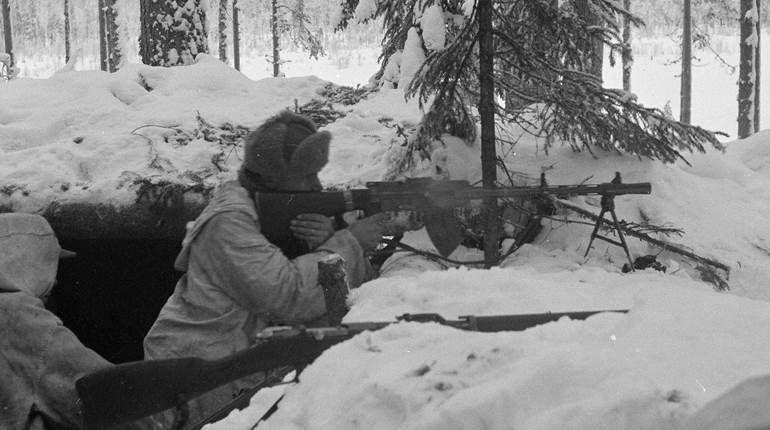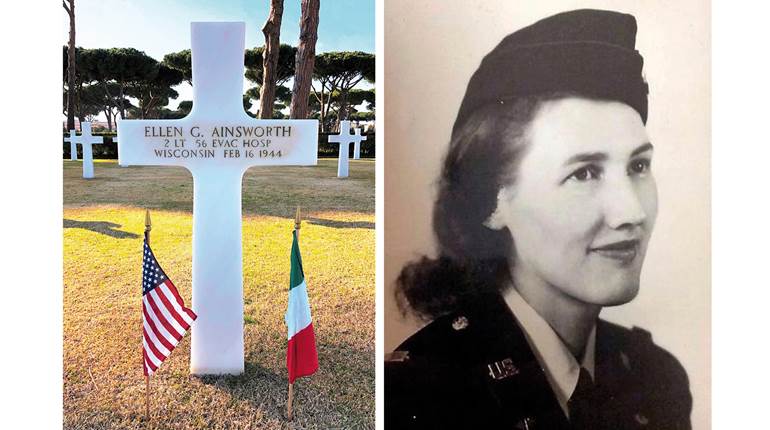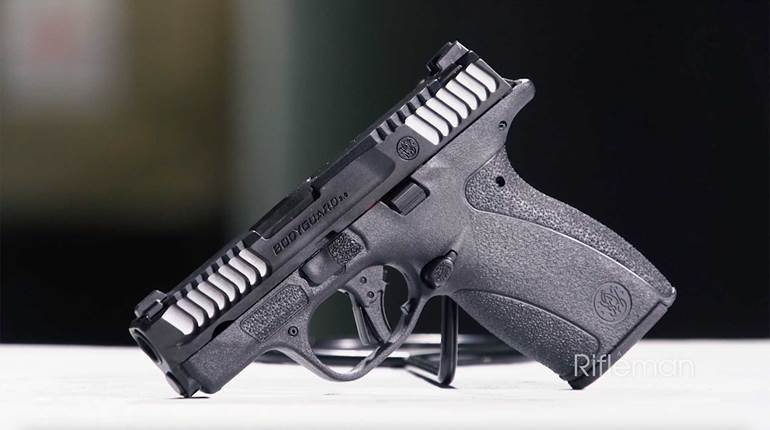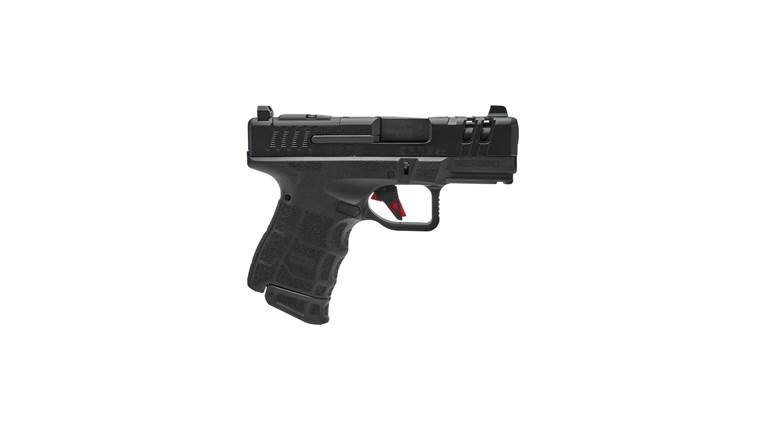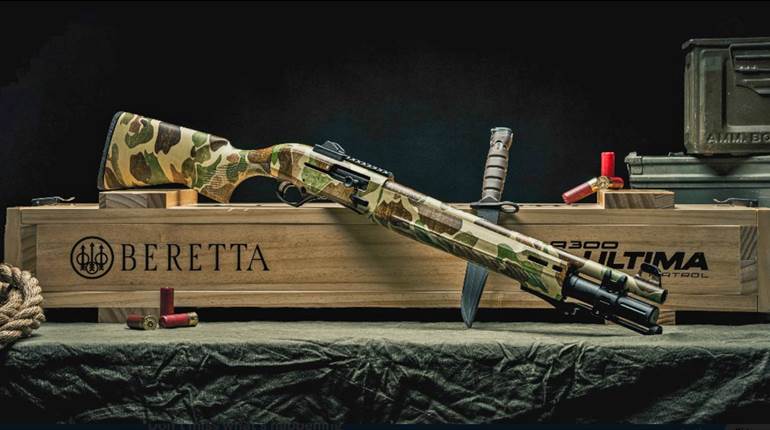
In the aftermath of the Second World War, the Czechoslovak Army decided that the time had come to retire the rifle it had adopted two decades earlier: the old vz.24 in 8x57 mm Mauser. It was certainly a rugged and reliable design in every category, but the manually operated bolt-action service rifle just did not have much of a future in the atomic age. With the M1 Garand, the U.S. had proven that it was possible to mass-produce a self-loading service rifle, so that was clearly the goal to work toward, but full-power rifle cartridges like .30-'06 Sprg. and 8x57 mm also began to fade toward obsolescence after 1945.
 A 7.62x45 mm cartridge (left) and a 7.62x51 NATO cartridge (right) are seen here with an original box of Czech 7.62x45 mm ammunition and a loaded vz.52 rifle magazine. Image courtesy of Martin K.A. Morgan.
A 7.62x45 mm cartridge (left) and a 7.62x51 NATO cartridge (right) are seen here with an original box of Czech 7.62x45 mm ammunition and a loaded vz.52 rifle magazine. Image courtesy of Martin K.A. Morgan.
During the war years, Germany and the Soviet Union had proven that rimless bottlenecked intermediate cartridges like 7.92x33 mm and 7.62x39 mm were practical for use on the modern battlefield, so post-war service rifle designs embraced the concept by shifting toward cartridges that were not quite as powerful but nevertheless capable. The timing of this development program was remarkable, really. Just as the “Iron Curtain” began to fall across eastern Europe, Czechoslovakia decided to combine these new ideas in the design of a domestically produced magazine-fed, semi-automatic rifle capable of delivering accurate fire out to 1,000 meters. The new cartridge would have to come first, though, so development of it began in late 1946 with work at first proceeding on a 7.5x55 mm load. Eventually, the Czech Military Technical Institute increased the bullet’s diameter, decreased overall case length, and then concluded design development in 1950 with the adoption of 7.62x45 mm. By then, both Zbrojovka Brno and the Czech Munitions Factory (CZ) of Strakonice had turned out promising rifle prototypes, but it was the gun designed at CZ by Jan and Jaroslav Kratochvíl that was ultimately selected for further development. In 1951, changes were introduced after preliminary test and evaluation of the CZ factory prototype, and one year later—in March 1952—the rifle was adopted under the formal designation 7,62mm samonabíjecí puška vzor 52.
 Left-side view of a vz.52/57 rifle in 7.62×39 mm that was made in 1959. Image courtesy of Jeff Hallinan of Collectors Firearms in Houston, Texas.
Left-side view of a vz.52/57 rifle in 7.62×39 mm that was made in 1959. Image courtesy of Jeff Hallinan of Collectors Firearms in Houston, Texas.
The vz.52 was both conventional and unconventional at the same time. Its detachable 10-round box magazine was not necessarily innovative, as several other self-loading rifles that came before it used a similar feeding system. It was a gas-operated design, which, in and of itself, was not an innovation, but the vz.52’s annular short-stroke gas piston presented a unique feature that set it apart from other gas-operated service rifles. Another unique feature was the rifle’s 10.6”, non-removable knife bayonet that was designed to fold into a corresponding recess in the right side of the wooden stock. Weighing in at 9.13 lbs., it was heavier than the SKS (8.5 lbs.) but slightly lighter than the Garand (9.5 lbs.), so it was a little on the substantial side in terms of mass. Nevertheless, the vz.52 provided Czech troops with the kind of firepower that the semi-automatic service rifle development program specified back in 1946. But it was not the only new firearm in 7.62x45 mm that the Czech military would adopt in 1952.
 Left-side view of a Post-'86 dealer sample vz.52/57 light machine gun in 7.62×39 mm, and its ammunition box/belt-keeper. Image courtesy of Martin K.A. Morgan.
Left-side view of a Post-'86 dealer sample vz.52/57 light machine gun in 7.62×39 mm, and its ammunition box/belt-keeper. Image courtesy of Martin K.A. Morgan.
Part of the rationale driving the development of an intermediate cartridge from the start was the idea that both a self-loading service rifle and a light machine gun (LMG) would ultimately be developed to shoot it. Toward that end, the well-known gun designer Václav Holek of Zbrojovka Brno began the development of a modified/improved ZB vz.26 light machine gun that the Czech military ultimately adopted on May 24, 1952 under the official designation 7,62mm lehký kulomet vzor 52. So yes, the Czechs had two vz.52s: one a rifle, and one a light machine gun—both chambered for the 7.62×45 mm cartridge. Holek simply took all the best elements of his ZB vz.26, pulled them into the design of the new vz.52 LMG and added the capability to feed from a proprietary 50-round metallic belt. Like the ZB vz.26, the new LMG could also feed from a top-mounted, detachable-box magazine, and the barrel could be removed to avoid overheating. In fact, the barrel release lever also functioned as the magazine well cover when belts were being used.

The vz.52 LMG was a gas-operated, open-bolt design utilizing a tilting breechblock that weighed in at a modest 17.64 lbs.—almost 5 lbs. less than the ZB vz.26. Unlike the ZB vz.26, though, the vz.52 LMG’s design incorporated an MG34-type double-trigger providing semi-automatic fire when pulling the upper half, and fully automatic fire when pulling the lower half. It was designed to be fired using either its built-in bipod, from a vehicular mount or from the UL-1 fixed carriage. The gun’s most innovative feature was perhaps its pistol grip, which also functioned as the charging handle.
To retract the bolt to the rearward position and prepare to fire, the shooter pulled down on a release on the left side of the grip and then slid the entire assembly forward until it reached the end of travel. Then, as the shooter pulled the pistol grip assembly rearward to return it to its original position, the action retracted the bolt carrier to the point that it was held rearward by the sear. At the time of adoption in 1952, ZB’s vz.52 LMG was more than just a clever design—it was a technically innovative weapon that gave the Czech military the perfect counterpart to the new CZ vz.52 rifle.
 A Czech machine gunner and assistant gunner operating a vz.52/57 light machine gun during a field training exercise during the 1960s.
A Czech machine gunner and assistant gunner operating a vz.52/57 light machine gun during a field training exercise during the 1960s.
The vz.52s entered service at a complicated time in Czechoslovakia’s political history, and that would ultimately affect the service life of both guns in a unique way. After 84 months of German occupation, the end of World War II restored the democratic government that had existed before 1938. Once again, a united national state of Czechs and Slovaks, the country entered a brief period of relative tranquility during which free, open multi-party elections took place, and the media, the church and even opposition political parties existed free of state control.
At the time, it looked as if Czechoslovakia would remain an independent and sovereign nation free from foreign domination, but all of that began to change in 1947 over the issue of accepting Marshall Plan aid from the United States. The Communist Party of Czechoslovakia (KSČ) had secured 38 percent of the vote in the 1946 national election, and it therefore represented a critical constituency of the nation’s electorate and an influential element of the so-called “National Front” ruling coalition. Although at first inclined to accept it, the KSČ reversed its position on Marshall Plan assistance because it received instructions to do so from Moscow.
The controversy that this situation stirred up led eventually to a sudden drop in the KSČ’s popularity, and it began to look like the party would be soundly defeated in the national elections scheduled for May 1948. Rather than sit back and allow the KSČ to lose in Czechoslovakia the way that communist parties in France and Italy had recently lost, the Kremlin ordered the KSČ to seize power before the election could be held. Starting on Feb. 21, 1948, armed communist militias and sympathetic communist police took over Prague, and mass demonstrations shut the rest of the country down. Fearing the outbreak of civil war and possibly even a Soviet invasion, President Edvard Beneš gave in to the coup d'état on February 25th in a capitulation that marked the beginning of four decades of communist rule.
 A Czech light machine gun team running a vz.52 in 7.62x45 mm. The gunner (right) is inserting a magazine, and the assistant gunner (left) has positioned the magazine carrying box for the vz.52 in the snow in front of him. He is armed with the Sa 23 (vz.48a) submachine gun.
A Czech light machine gun team running a vz.52 in 7.62x45 mm. The gunner (right) is inserting a magazine, and the assistant gunner (left) has positioned the magazine carrying box for the vz.52 in the snow in front of him. He is armed with the Sa 23 (vz.48a) submachine gun.
Although the program that developed the 7.62x45 mm cartridge, the vz.52 rifle, and the vz.52 light machine gun began before the February 1948 coup, it completed all three designs after the communists established the Czechoslovak Socialist Republic. Critically, though, all three items entered service at a moment in Cold War history when the “Iron Curtain” had already separated the Eastern Bloc from the West, but the Warsaw Pact collective security alliance had not yet been formed. That would not happen until May 14, 1955, and an important consequence of that alliance was that the member nations would eventually agree to standardize military equipment, weapons, and—most importantly—ammunition.
But change did not happen overnight, and it took time for the Warsaw Pact member nations to finalize the agreement that standardized the 7.62x39 mm cartridge for rifles and light machine guns. This gave Czechoslovakia a little time to figure out what to do with its vz.52 rifles and light machine guns. Both designs were still quite modern by the standards of the mid-1950s, and the examples that had been produced up to that point were still well within their service life, so replacing them would have been wasteful of time and resources. Rather than doing that, it was decided to convert both to the Soviet caliber.
 A vz.52/57 light machine gun in 7.62x39 mm mounted in the UL-1 carriage for use in fixed defensive positions as seen in the Border Defense Minimuseum of the town of Dyjákovičky, South Moravia on the Austrian border 50 miles north of Vienna.
A vz.52/57 light machine gun in 7.62x39 mm mounted in the UL-1 carriage for use in fixed defensive positions as seen in the Border Defense Minimuseum of the town of Dyjákovičky, South Moravia on the Austrian border 50 miles north of Vienna.
The vz.52 rifle required a new barrel chambered for 7.62x39 mm, a new rear sight with graduations appropriate for the 7.62x39 mm cartridge’s more modest external ballistics, a new magazine compensating for the 7.62x39 mm cartridge’s shorter overall case length, and a new cleaning kit. The vz.52 light machine gun also required a new barrel chambered for 7.62x39mm, different spacers in the top cover that would align the shorter 7.62x39 mm cartridge for introduction to the chamber, a new, smaller ammunition box/belt keeper compensating for the 7.62x39 mm cartridge’s shorter overall case length, and a redesigned magazine to compensate for the cartridge’s tapered case wall.
Václav Holek, the Bohemian gun designer responsible for so many of the 20th century’s most notable firearms and the mind behind the vz.52 light machine gun, passed away in November 1954, so he did not do any of the engineering work on the 7.62x39 mm conversion. That was done by an engineer named Jaroslav Myslík of Konštrukta Národní Podnik in Brno, a defense company that still exists today under the name Konštrukta-Defence. The caliber-converted vz.52s both received the designation vz.52/57, and they both entered service in the Czechoslovak People's Army (the ČSLA) in 1959, but one would enjoy greater longevity than the other.
 A 7.62x39 mm cartridge (left), a 7.62x45 mm cartridge (center), and a 5.56 NATO M855A1 cartridge (right) are seen here together for comparison. In the background is an original box of Czech 7.62x45 mm ammunition and five stripper clips loaded with 7.62x45 mm cartridges for the vz.52 rifle. Image courtesy of Martin K.A. Morgan.
A 7.62x39 mm cartridge (left), a 7.62x45 mm cartridge (center), and a 5.56 NATO M855A1 cartridge (right) are seen here together for comparison. In the background is an original box of Czech 7.62x45 mm ammunition and five stripper clips loaded with 7.62x45 mm cartridges for the vz.52 rifle. Image courtesy of Martin K.A. Morgan.
Just a year after the adoption of the caliber conversion vz.52/57s, the ČSLA adopted an innovative select-fire rifle that was chambered for the Soviet caliber from the start. This rifle went into development the year after the establishment of the Warsaw Pact, and it received the designation vz.58 before entering Czech military service in 1959. Because it was the superior rifle design all the way around, the vz.52/57 rifle faded quickly. Examples continued to serve for a few years in Czech reserve units, but mass production of the vz.58 replaced even those within a short span of time.
Still, the vz.52/57 rifle showed-up in Cold War flashpoints from Southeast Asia, to Africa, the Middle East and even the Caribbean. It can be seen today arming the ceremonial guards at Prague Castle, but that is about all the vz.52/57 rifle has been doing for the last four decades. The 8,000 vz.52/57 LMGs that were produced, on the other hand, served the ČSLA from adoption in April 1959 to 1964, when they were replaced once and for all by a general-purpose machine gun chambered for the Russian 7.62x54 mm R cartridge: Univerzální kulomet vzor 59 - or Uk vz.59.
 Close-up of the left side of the receiver of a Post-'86 dealer sample vz.52/57 light machine gun in 7.62x39 mm showing its MG34 type double-trigger and the release lever/safety that allows the pistol grip to function as the cocking handle. Image courtesy of Martin K.A. Morgan.
Close-up of the left side of the receiver of a Post-'86 dealer sample vz.52/57 light machine gun in 7.62x39 mm showing its MG34 type double-trigger and the release lever/safety that allows the pistol grip to function as the cocking handle. Image courtesy of Martin K.A. Morgan.
The vz.52/57 LMG also armed the Republic of Cuba starting in 1960, and then the Republic of Biafra during its brief existence as a sovereign nation from 1967 to 1970. Although its days as a military small arm ended during the Nigerian Civil War, the vz.52/57 LMG fathered design characteristics that carried over to the Uk vz.59—a machine gun that remains in service to this day (although converted to 7.62 NATO). In this way, the spirit of Václav Holek—the man who brought us the ZB vz.26, the BREN gun and the vz.52—is still with us today.
When you consider that his last military design had to adapt to the tense power struggle of the Cold War and become the vz.52/57, you have to acknowledge that it is more than just a light machine gun: it is also a metaphor for the political upheavals that took place in post-World War II Europe. Together with the caliber-converted vz.52/57 rifle, the caliber-converted vz.52/57 LMG reminds us of a time when Soviet hegemony over its Eastern European satellite states forced one of them to abandon a perfectly good cartridge in the interests of conformity. Both vz.52/57s can be found in the U.S. today, and they call our attention to a time when an “Iron Curtain” extended across the European continent and membership in the Warsaw Pact compelled Czechoslovakia to adopt 7.62x39 mm.
 Right-side view of a Post-'86 dealer sample vz.52/57 light machine gun in 7.62x39 mm and its ammunition box/belt-keeper. Image courtesy of Martin K.A. Morgan.
Right-side view of a Post-'86 dealer sample vz.52/57 light machine gun in 7.62x39 mm and its ammunition box/belt-keeper. Image courtesy of Martin K.A. Morgan.












